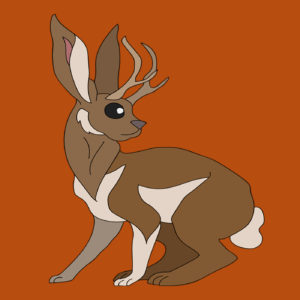Jackalope (jahk-ah-lohp)
Jackalopes were jackrabbits with tiny antlers atop their heads. They were traditionally viewed as docile creatures, but were very territorial and would gore a predator if threatened. Jackalopes were among the first animals to try mimicking human speech as a defense mechanism. Children took advantage of this and taught them some foul words. Its antlers were the one thing that separated a jackalope from a jackrabbit. Antlers started growing at about five months in a thin casing of fur known as velvet. This was rubbed off as jacks reached maturity leaving the small brittle antlers it was known for. They did not burrow into the ground, as was commonly mistaken. Instead, they preferred to bed in a nice grassy area close to water where the tall grasses and reeds camouflaged them quite nicely. Travelers wore thick hide around their shins when they traveled in these large areas to keep from getting gored when they accidentally strayed across a jackalope bed.
A jackalope was part rabbit and bred like them too. Litters were typically ten or more. Young jackalopes are kittens until they reached the age of seven months at which point males became “Jacks” and females were “Jills.” Jills didn’t grow antlers and were easily confused with normal jackrabbits. A group was referred to as a “nest.” Shrubs, small trees, fruit, grass, and vegetables make up the jackalope’s diet. Jackalopes were particularly drawn toward farms where abundant sources of food can be found. Farmers saw them as pests and many days were spent shooing jackalopes away.

